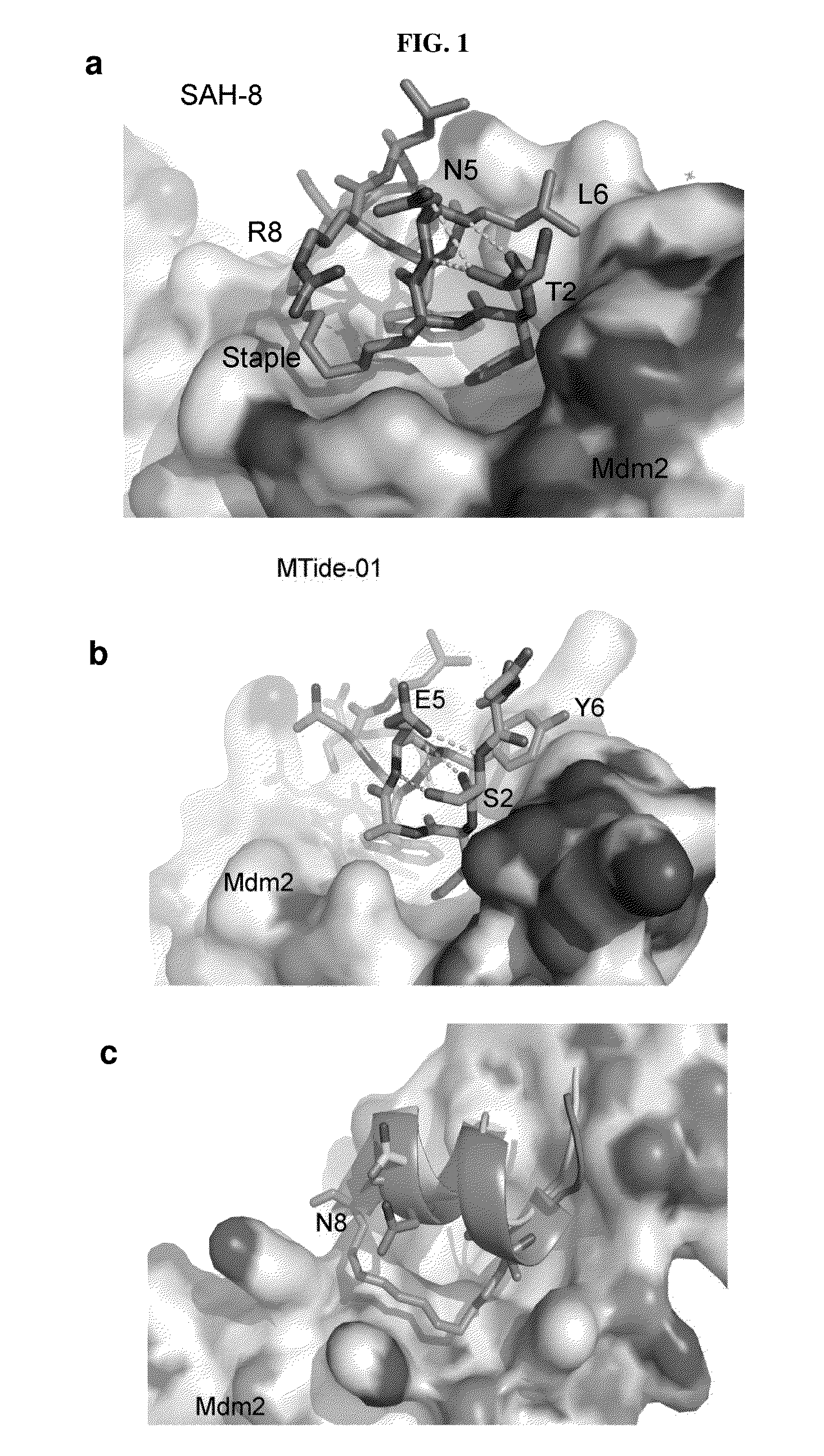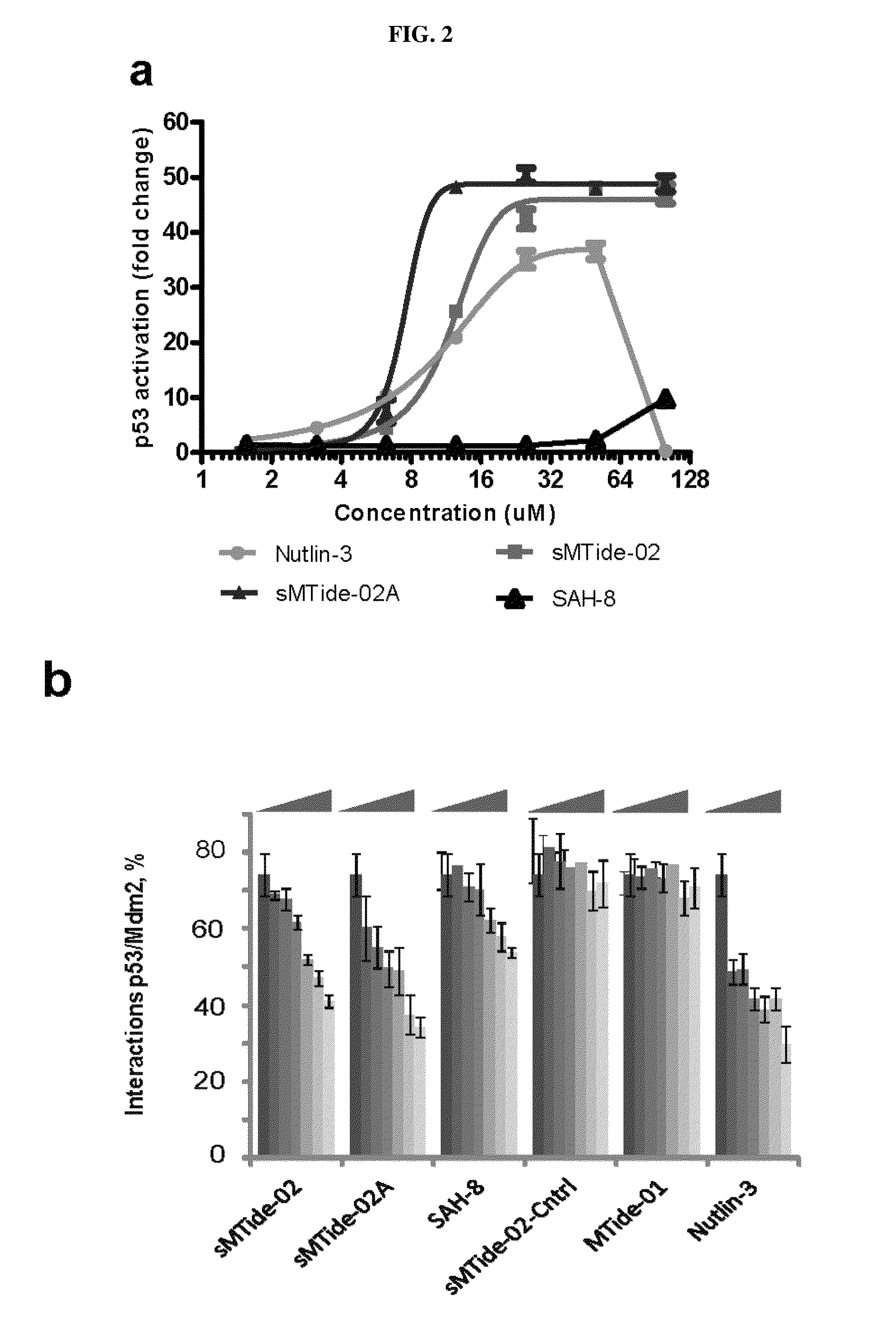Peptides and methods for treating cancer
a technology of peptides and cancer, applied in the direction of peptides/protein ingredients, carrier-bound/immobilised peptides, peptides, etc., can solve the problems of peptides that are not functional in the presence of serum, and exhibit off-target toxicity to p53-null cells
- Summary
- Abstract
- Description
- Claims
- Application Information
AI Technical Summary
Benefits of technology
Problems solved by technology
Method used
Image
Examples
example 1
[0102]This example demonstrates the selection of the most suitable peptide for binding to Mdm2 / Mdm4 by a combining phage display and computational techniques. The currently most avid published peptides were used as the template for this study. One of these peptides, termed MTide-01 (T1SFAEYWNLLS11; having the amino acid SEQ ID NO: 4), interacts strongly and specifically with Mdm2 / Mdm4 with low nanomolar Kds (Table 1).
TABLE 1Apparent Kds were determined by competitive fluorescence polarization.Presence of I, I + 7 macrocyclic hydrocarbon bridge indicated by X.Mdm2 KdMdm4 KdSEQ IDLigandPrimary Sequence(nM)(nM)NO:MTide-01Ac-1TSFAEYWNLLS11-NH246.34 ± 6.8933.16 ± 4.624sMTide-01Ac-1TSFXEYWNLLX11-NH286.99 ± 0.02118.3 ± 0.045MTide-02Ac-1TSFAEYWALLS11-NH228.04 ± 1.3816.33 ± 2.006sMTide-02Ac-1TSFXEYWALLX11-NH234.35 ± 2.0345.73 ± 7.657sMTide-02AAc-1TSFXEY(L-6-Cl)WALLX11-NH2 6.76 ± 2.111360 ± 6008sMTide-02BAc-1TSFXEY(D-6-Cl)WALLX11-NH288.16 ± 7.202160.73 ± 1000 9SAH-8Ac-QSQ1QTFXNLWRLLX11QN-NH21...
example 2
[0105]This example provides a comparison of the affinity of the peptides of the present invention and previously disclosed peptides for Mdm2 / Mdm4. sMTide-02 yielded the most potent derivative with a Kd of 34.60±2.03 nM against Mdm2 and a Kd of 45.73±7.65 nM against Mdm4 (Table 1). In comparison to their unstapled counterparts, both peptides exhibited slightly weaker Kds with sMTide-01 showing an approximately 2-fold increase against Mdm2 and a 4-fold increase against Mdm4. In contrast, sMTide-02 had a negligible increase against Mdm2 whilst showing a 2-fold increase in Kd against Mdm4. These results validate the hypothesis that N8 interferes with the staple and the stabilization of the helix within sMTide-01. Both peptides were then tested for biological activity (FIG. 1 (d)). sMTide-01 displayed little activity in a T22 derived p53 reporter cell line. Surprisingly, it was discovered that sMTide-02 induced the strongest p53 transcriptional response ever seen in this assay, which has...
example 3
[0111]This example provides a titration of p53 activating peptides. Titrations of p53 activating compounds into the T22 assay typically produced a bell shaped curve in which high concentrations of compound produced lower levels of reporter protein as a result of cell toxicity. Remarkably, while nutlin induced a typical bell shaped curve, the two peptides showed a sigmoidal curve with a plateau over a large dose range, with much higher levels of reporter protein production, indicating that these compounds lack cell toxicity despite their ability to activate p53 function to high levels (FIG. 2a). However, both stapled peptides at low concentrations induced less p53 activity than nutlin, indicating that the dynamics of cell entry for these molecules are different.
[0112]To further investigate the mechanism of action of the stapled peptides in live cells, a fully reversible cellular protein-protein interaction assay was used. The Fluorescent 2-Hybrid (F2H) assay (ChromoTek GmbH) is a mic...
PUM
| Property | Measurement | Unit |
|---|---|---|
| length | aaaaa | aaaaa |
| fluorescent | aaaaa | aaaaa |
| nucleic acid | aaaaa | aaaaa |
Abstract
Description
Claims
Application Information
 Login to View More
Login to View More - R&D
- Intellectual Property
- Life Sciences
- Materials
- Tech Scout
- Unparalleled Data Quality
- Higher Quality Content
- 60% Fewer Hallucinations
Browse by: Latest US Patents, China's latest patents, Technical Efficacy Thesaurus, Application Domain, Technology Topic, Popular Technical Reports.
© 2025 PatSnap. All rights reserved.Legal|Privacy policy|Modern Slavery Act Transparency Statement|Sitemap|About US| Contact US: help@patsnap.com



